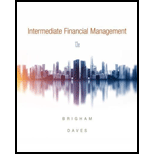
a)
To determine: The definition of interest tax shield and value of tax shield.
a)
Explanation of Solution
The interest tax shield is the amount of cash flow shielded from taxes due to interest tax deductibility. It's the same as
Because MM assume zero growth, the value of the tax shield is T(D). If growth is constant, then the value of the tax shield is
b)
To determine: The definition of adjusted present value (APV) model.
b)
Explanation of Solution
The adjusted present-value model discounts expected free cash flows at rTS's unlevered
c)
To determine: The definition of compressed adjusted present value (CAPV) model.
c)
Explanation of Solution
The condensed modified present-value method discounts expected free cash flows at the unlevered equity cost and also discounted interest tax shields at the unlevered equity cost to determine the value of transactions. It is called the compact APV because there is a discount on the FCF and tax shields at the same price.
d)
To determine: The definition of
d)
Explanation of Solution
This then reduces the FCFEs to hit the price of capital in operations at the leveraged cost of equity. You apply non-operating capital to the value and you get the equity value. You then apply the price of the loan to the value of the transactions. First, the free cash flow for the equity model, or the residual dividend model, measures FCFE, the free cash flow owned by shareholders. FCFE is less interest in cost-free cash flow plus interest tax shield.
Want to see more full solutions like this?
Chapter 17 Solutions
Intermediate Financial Management (MindTap Course List)
- An overall capitalization rate (Ro) is divided into which type of income or cash flow to obtain an indicated market value? Multiple Choice Net operating income (NO) Effective gross Income (EG) Before-tax cash flow (BTCA) After-tax cash flow (ATCA) Potential gross income (PG)arrow_forwardWhich one of the following is most closely related to the net present value profile? A: Payback B: Discounted payback C: Profitability index D: Average accounting return E: Internal rate of returnarrow_forwardHow is the impact of uncertainty reflected in a discounted cash flow (DCF) analysis?a) Debt/equity mixb) Discount ratec) Income tax rated) Interest coverage ratioarrow_forward
- Define each of the following terms: c. Net present value (NPV) method; internal rate of return (IRR) method;profitability index (PI)arrow_forwardDefine each of the following terms:b. Spontaneous liabilities; profit margin; payout ratioarrow_forwardDescribe how the following factors affect external capitalrequirements: (1) payout ratio, (2) capital intensity, (3) profitmargin.arrow_forward
- What is calculation of before Tax (Equity) Cash Flow? Please provide example.arrow_forwardWhich of the following may take the form of dividend income and/or capital appreciation? a. bond investments b.gain from an investment c.equity investments d.expected rate of returnarrow_forwardWhich of the following methods consider the time value of money? A. payback and accounting rate of return B. payback and internal rate of return C. internal rate of return and accounting rate of return D. internal rate of return and net present valuearrow_forward
- Need help calculating: A. Economic value added and B. Return on Capitalarrow_forwardDefine each of the following terms: f. Dividend reinvestment plan (DRIP)arrow_forward,Match the following terms with the appropriate definition.Effective yield or interest rateMonetary liabilityCompound interestPresent ValueFuture value of a single amountA.Fixed obligation to pay an amount in cash.B.The rate at which money will actually grow.C.Interest accumulates on interest.D.Current worth of future cash flows.E.The money to which an amount invested will grow over time.arrow_forward
 Intermediate Financial Management (MindTap Course...FinanceISBN:9781337395083Author:Eugene F. Brigham, Phillip R. DavesPublisher:Cengage Learning
Intermediate Financial Management (MindTap Course...FinanceISBN:9781337395083Author:Eugene F. Brigham, Phillip R. DavesPublisher:Cengage Learning

